
views
Preparing to Check Your Blood Pressure

Verify that you have the right cuff size. A standard size blood pressure cuff purchased from a drugstore will fit around the arm of most adults. However, if you have an especially narrow or wide arm, or if you plan to take the blood pressure of a child, you may need a different size. Check the size of a cuff before buying it. Look at the "index" line. This is the range line on the cuff that tells you if it fits. Once it is on the patient's arm it will tell you whether or not the circumference of your arm fits within the "range" area of the cuff. If you do not use the proper cuff size, you may end up with an inaccurate measurement.
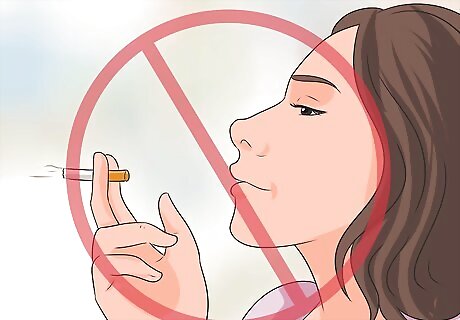
Avoid factors that can increase blood pressure. Certain conditions can cause blood pressure to spike temporarily. In order to get an accurate measurement, you or your patient should avoid these conditions before taking your blood pressure. Factors that can affect blood pressure include: stress, smoking, exercise, cold temperatures, a full stomach, a full bladder, caffeine, and some medications. Blood pressure can change throughout the course of the day. If you need to check the patient's blood pressure regularly, try to do so at the same approximate time each day.

Find a quiet place. You will need to listen your, or your patient's heartbeat, so a quiet setting is ideal. A quiet room is also a calm room, so someone who rests in a quiet room while checking his or her blood pressure is more likely to feel relaxed, rather than stressed. Therefore you are more likely to get an accurate reading.

Get comfortable. Since physical stress can affect a blood pressure reading, you or the patient whose reading you take, should get comfortable. For example, use the bathroom before you have your blood pressure taken. It's also a good idea to keep yourself warm. Find a warm room, or if the room is chilly, wear an extra layer of clothing to keep warm. In addition, if you have a headache or body ache, try to reduce or relieve the pain before taking your blood pressure.
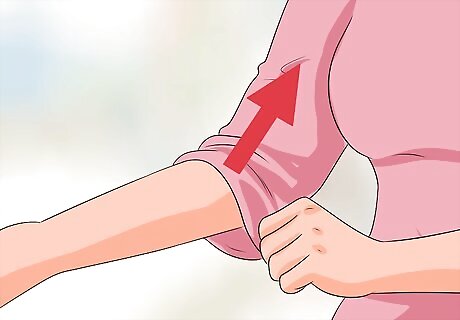
Remove tight sleeves. Roll up your left sleeve or, better yet, change into a shirt that exposes your upper arm. Blood pressure should be measured from the left arm, so the sleeve should be removed from the upper left arm.

Rest for 5 to 10 minutes. Resting will assure that your heart rate and blood pressure have the chance to stabilize before the measurement is taken.
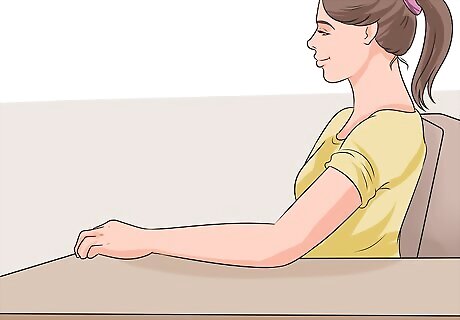
Find a comfortable and appropriate location to take your blood pressure. Sit in a chair next to a table. Rest your left forearm on the table. Position your left arm so that it rests at about heart level. Keep the palm of your hand facing up. Sit up straight. Your back should be against the back of the chair and your legs should be uncrossed.
Positioning the Blood Pressure Cuff
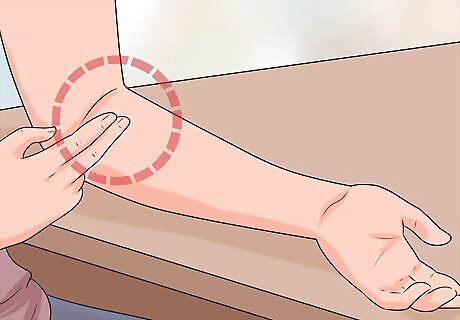
Locate your pulse. Place your index and middle fingers over the inside center of your inner elbow. When you press lightly you should be able to feel the pulse of your brachial artery from this position. If you have difficultly locating your pulse, place the head of the stethoscope (the round piece at the end of the tube) in the same general area and listen until you can hear your heartbeat.

Wrap the cuff around your arm. Tuck the cuff end through the metal loop and slide it onto your upper arm. The cuff should be roughly 1 inch (2.5 cm) above the bend of your elbow and should be evenly tight around your arm. Make sure that your skin is not pinched by the cuff as you wrap it securely. The cuff should have heavy duty velcro on it, which will hold the cuff closed.

Check the tightness of the cuff by slipping two fingertips underneath. If you can wiggle the two fingertips under the top edge but cannot wedge your full fingers beneath the cuff, the cuff is tight enough. If you can wedge your full fingers under the cuff then you need to open up the cuff and pull it tighter before closing it again.

Slide the head of the stethoscope under the cuff. The head should be face down, with the wide part of the chest piece in contact with the skin. It should be positioned directly over the pulse of your brachial artery that you found earlier. Also place the stethoscope earpieces in your ears. The earpieces should face forward and point toward the tip of your nose.

Position the gauge and the pump. The gauge needs to be positioned where you can see it. Hold the gauge lightly in the palm of your left hand if taking your own blood pressure. If taking someone else's blood pressure, you can hold the gauge in whatever position you want as long as you can see the face of the gauge clearly. You should hold the pump in your right hand. Turn the screw on the pump bulb clockwise to close the airflow valve, if necessary.
Measuring Your Blood Pressure

Inflate the cuff. Rapidly squeeze the pump bulb until you no longer hear the sound of your pulse through the stethoscope. Stop once the gauge reads 30 to 40 mmHg above your normal blood pressure. If you do not know your normal blood pressure, inflate the cuff until the gauge reads between 160 to 180 mmHg.

Deflate the cuff. Open the airflow valve by twisting the screw counterclockwise. Let the cuff deflate gradually. The gauge should fall 2 mm, or two lines on the gauge, per second.

Listen for the systolic reading. Note the measurement on your gauge at the precise moment you hear your heartbeat again. This measurement is your systolic reading. Systolic blood pressure refers to the force your blood exerts against the artery walls as your heart pumps. This is the blood pressure created when your heart contracts. Gain confidence by taking vital signs. "As an assistant care worker trainee, I was anxious about properly measuring blood pressure. This guide’s clear visuals and step-by-step instructions built my confidence. After practicing the techniques for eliminating error factors and correctly positioning the cuff, I can now reliably record accurate manual blood pressure readings." - Petar N. Ace the assignment with an excellent graphic. "I used this article’s detailed illustrations to create an A+ graphic organizer for class explaining the process of checking blood pressure. The images clearly demonstrate proper cuff size, placement, and use. I understood the techniques so well I also taught my parent how to measure their blood pressure at home." - Josh D. Master the method through clear explanations. "Many articles tried to teach this technique using complex medical terminology. This one had easy-to-understand directions plus effective pictures illustrating each step. After a little practice, I can now consistently find systolic and diastolic readings. My confidence in this vital but often intimidating skill has greatly increased." - Curtis W. J. Take accurate readings without specialty tools. "As someone with high blood pressure, I needed to monitor myself daily. This guide taught me how to take precise manual blood pressure measurements using just a basic cuff kit. Thanks to the clear instructions for placement and detecting readings by sound, I can track my levels at home without an expensive digital monitor or stethoscope." - Ivonne B. Have a story our readers should hear? Share it with 1 billion+ annual wikiHow users. Tell us your story here.

Listen for the diastolic reading. Note the measurement on your gauge at the precise moment the sound of your heartbeat disappears. This measurement is your diastolic reading. Diastolic blood pressure refers to your blood pressure in between heartbeats.

Rest and repeat the test. Let the cuff completely deflate. After several minutes, follow the same steps to take another measurement. If your blood pressure is still high, consider comparing readings with the other arm. Mistakes can happen while taking your blood pressure, especially if you are not used to doing it. As such, it is important to double-check your findings by taking a second measurement.
Interpreting the Results

Know what normal blood pressure should be. For an adult, the systolic blood pressure should be less than 120 mmHg and the diastolic blood pressure should be less than 80 mmHg. This range is considered "normal." Healthy behaviors, including diet and exercise, should be maintained in order to maintain this blood pressure range.
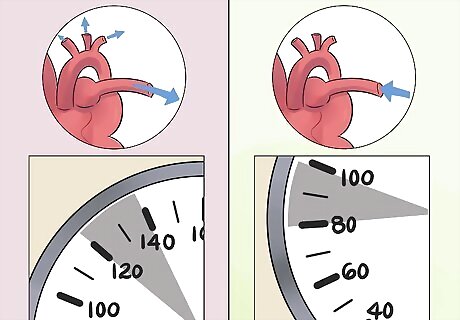
Catch signs of prehypertension. Prehypertension is not necessarily dangerous by itself, but someone with prehypertension is at risk of experiencing hypertension in the future. An adult in a state of prehypertension will have a systolic blood pressure between 120 and 139 mmHG and a diastolic blood pressure between 80 and 89 mmHg. Talk to a health care professional about making changes to your diet and lifestyle in order to drop your blood pressure.

Detect signs of stage 1 hypertension. During state 1 hypertension, also known simply as high blood pressure, an adult's systolic blood pressure is between 140 and 159 mmHg. The diastolic blood pressure is between 90 and 99 mmHg. Hypertension requires professional medical care. Schedule an appointment with your doctor so that he or she may prescribe an appropriate hypertension medication.
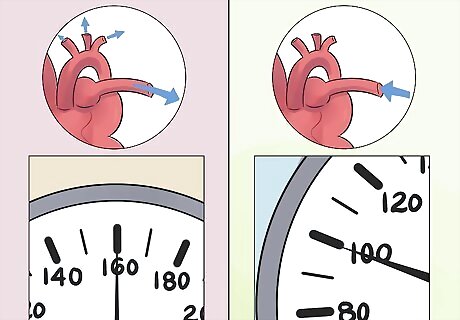
Assess whether you have stage 2 hypertension, also known as high blood pressure. This is a serious condition and requires prompt medical care. If your systolic blood pressure is at or above 160 mmHg and your diastolic blood pressure is at or above 100 mmHG, you have stage 2 hypertension.

Understand that blood pressure can also be too low. If your systolic blood pressure stays around 85 mmHg and your diastolic blood pressure remains around 55 mmHG, your blood pressure may be too low. Symptoms of low blood pressure include lightheadedness, fainting spells, dehydration, lack of concentration, vision problems, nausea, fatigue, depression, rapid breathing, and clammy skin. Talk with your doctor to discuss possible reasons behind your drop in blood pressure and possible ways to raise it up to normal levels.
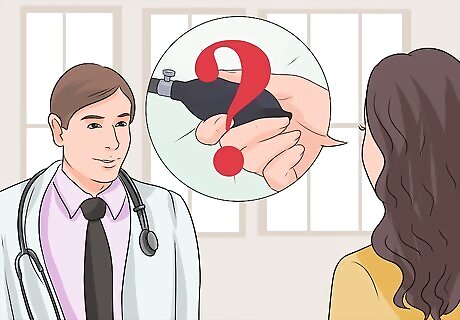
Consult a physician if you suspect you have any stage of hypertension or low blood pressure. Your doctor will retest your blood pressure to make sure your readings are accurate. If you do have hypertension, or prehypertension, your doctor will make recommendations for lowering your blood pressure. This will include lifestyle changes, if you have prehypertension, in addition to medication if you have actual hypertension. The doctor may also test for other conditions that hinder normal blood pressure, especially if the patient is already on medication. If you are already on medication for your blood pressure, your doctor may suggest therapy or consider testing for additional health problems that prevent the medication from working properly.




















Comments
0 comment